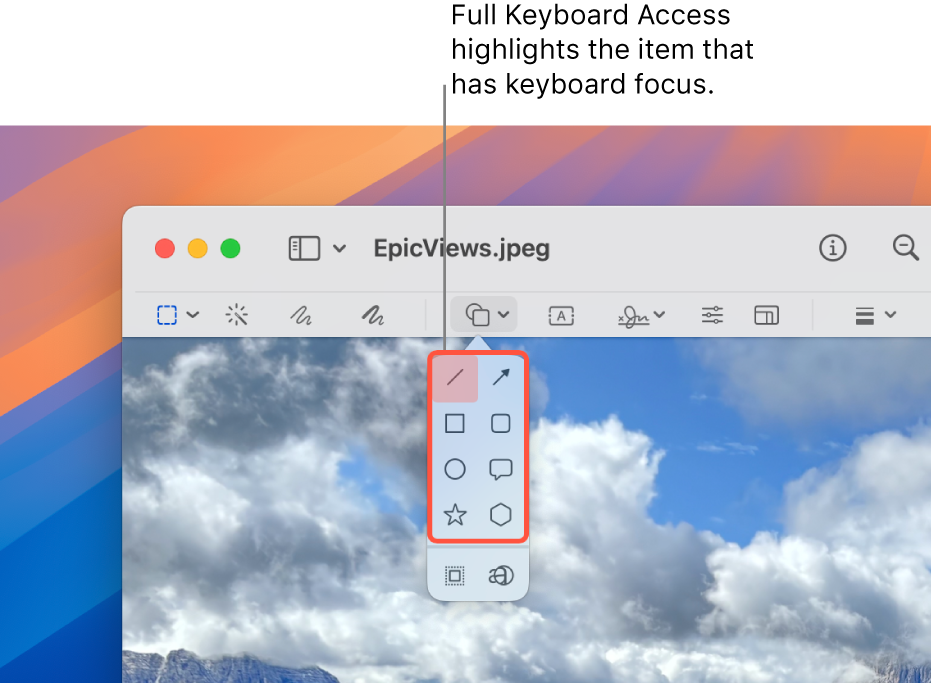
Navigate your Mac using Full Keyboard Access
With Full Keyboard Access turned on, you can use the keyboard to navigate your Mac, instead of using a mouse or trackpad. Full Keyboard Access highlights the item on the screen that has focus. You can customise the colour, contrast and size of the highlight.

Turn Full Keyboard Access on or off
On your Mac, choose Apple menu

 in the sidebar. (You may need to scroll down.)
in the sidebar. (You may need to scroll down.)Go to Motor, click Keyboard, then turn Full Keyboard Access on or off.
Navigate using Full Keyboard Access
When Full Keyboard Access is turned on, do any of the following using the default commands:
Move to the next UI element: Press the Tab key.
Move to the previous UI element: Press Shift-Tab.
Select an item: Press the Space bar.
Move inside a group (such as a list of files in a folder or items in a sidebar): Press the Up Arrow or Down Arrow key or the Left Arrow or Right Arrow key. Full Keyboard Access highlights the group and the item within the group that has focus.
Move to the next item: Press Control-Tab.
Move to the previous item: Press Control-Shift-Tab.
Search for items: Press Tab-F.
Open the Window Chooser: Press Tab-W.
Open the Application Chooser: Press Tab-A.
Jump to the menu bar: Press Fn-Control-F2.
Jump to the Dock: Press Fn-A.
Open Control Centre: Press Fn-C.
Open Notification Centre: Press Fn-N.
Move the pointer to where the keyboard focus is: Press Tab-C.
View all Full Keyboard Access commands
When Full Keyboard Access is on, press Tab-H to open Commands Help, where you can view all Full Keyboard Access commands. You can also view a complete list in Full Keyboard Access settings.
Choose Apple menu

 in the sidebar, go to Motor, then click Keyboard (you may need to scroll down).
in the sidebar, go to Motor, then click Keyboard (you may need to scroll down).Click
 next to Full Keyboard Access, then scroll down to the list of commands.
next to Full Keyboard Access, then scroll down to the list of commands.
Customise Full Keyboard Access
You can change the keyboard shortcuts associated with the default Full Keyboard Access commands and set keyboard shortcuts for additional advanced commands. You can also customise the appearance of the Full Keyboard Access highlight.
On your Mac, choose Apple menu

 in the sidebar. (You may need to scroll down.)
in the sidebar. (You may need to scroll down.)Go to Motor on the right, then click Keyboard.
Click
 next to Full Keyboard Access.
next to Full Keyboard Access.Do any of the following:
Change how Full Keyboard Access looks: Choose options for the appearance of the Full Keyboard Access highlight, such as its colour, size and more.
Set a custom keyboard shortcut for a command: Scroll to Commands, click the command you want to customise the shortcut for, then press the key or keys you want to use as the shortcut.
Restore default keyboard shortcuts: Scroll to the bottom, then click Restore Defaults. This also removes keyboard shortcuts for advanced commands, if any.
Click Done.
Pause Full Keyboard Access
When Full Keyboard Access is on, you can use Pass-Through Mode to temporarily turn it off — for example, if you’re playing an online game and don’t want Full Keyboard Access to interfere with game interaction — then turn it back on.
Turn Pass-Through Mode on or off: Press Control-Option-Command-P.
If you don’t need the complete set of Full Keyboard Access commands, you can set an option to navigate to the next control on the screen by pressing the Tab key and navigate to the previous control by pressing Shift-Tab. Choose Apple menu 
![]() in the sidebar, then turn on “Keyboard navigation”.
in the sidebar, then turn on “Keyboard navigation”.
If you’re blind or have low vision, you can use VoiceOver keyboard commands to hear what’s on the screen, and navigate and interact with it. See the VoiceOver User Guide.